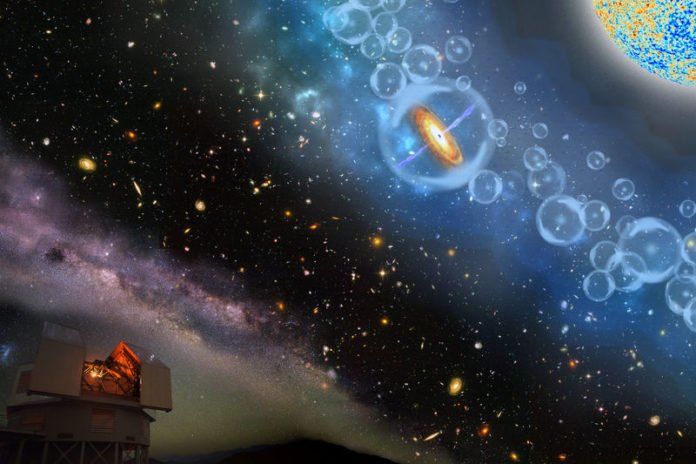A team of astronomers including MIT scientists has recently discovered the most distant supermassive black hole ever observed. The black hole sits in the focal point of an ultrabright quasar, the light of which was produced only 690 million years after the Big Bang.
This black hole is measured to be around 800 million times as huge as our sun.
Robert Simcoe, the Francis L. Friedman Professor of Physics at MIT said, “This is the only object we have observed from this era. It has an extremely high mass, and yet the universe is so young that this thing shouldn’t exist. The universe was just not old enough to make a black hole that big. It’s very puzzling.”
The researchers have derived that the black hole came to fruition similarly as the universe was experiencing a central move, from a hazy domain ruled by impartial hydrogen to one in which the principal stars began to squirt on.
According to scientists, this newly discovered supermassive black hole existed in an environment that was about half neutral, half ionized.
Simoc said, “What we have found is that the universe was about 50/50 — it’s a moment when the first galaxies emerged from their cocoons of neutral gas and started to shine their way out. This is the most accurate measurement of that time, and a real indication of when the first stars turned on.”
Scientists discovered the black hole while strengthing multiple all-sky surveys, or maps of the distant universe. While looking in particular for quasars — some of the brightest objects in the universe, that consist of a supermassive black hole surrounded by swirling, accreting disks of matter.
While identifying, several objects of interest, several objects of interest, scientists focused on in them by using the instrument called FIRE (the Folded-port Infrared Echellette), which operates at the 6.5-meter-diameter Magellan telescopes in Chile.
Using FIRE, the team identified one of Bañados’ objects as a quasar with a redshift of 7.5. Meanwhile, the object was emitting light around 690 million years after the Big Bang. In light of the quasar’s redshift, the analysts ascertained the mass of the dark gap at its inside and verified that it is around 800 million times the mass of the sun.
Simcoe said, “Something is causing gas within the quasar to move around at very high speed, and the only phenomenon we know that achieves such speeds is orbit around a supermassive black hole.”
Using FIRE, scientists determine that a large fraction of the hydrogen surrounding the quasar is neutral. They extrapolated from that to gauge that the universe, in general, was likely about half unbiased and half ionized at the time they watched the quasar. From this, they gathered that stars probably started turning on amid this time, 690 million years after the Big Bang.
Simcoe said, “This adds to our understanding of our universe at large because we’ve identified that moment of time when the universe is in the middle of this very rapid transition from neutral to ionized. We now have the most accurate measurements to date of when the first stars were turning on.”
Yet, scientists noted, there is a big mystery that remains unsolved- How did a black hole of such massive proportions form so early in the universe’s history? It’s felt that dark gaps develop by accumulating, or engrossing mass from the encompassing condition. To a great degree huge dark openings, for example, the one recognized by Simcoe and his associates, should frame over periods any longer than 690 million years.
Simcoe said, “If you start with a seed like a big star, and let it grow at the maximum possible rate, and start at the moment of the Big Bang, you could never make something with 800 million solar masses — it’s unrealistic. So there must be another way that it formed. And how exactly that happens, nobody knows.”
